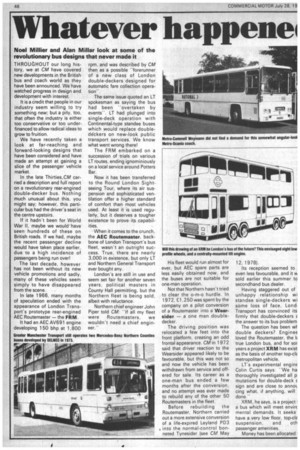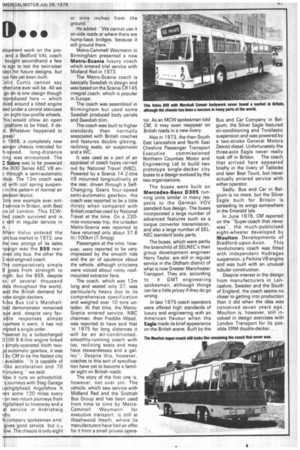Whatever happene
Page 48

Page 49

If you've noticed an error in this article please click here to report it so we can fix it.
Noel Millier and Alan Millar look at some of the revolutionary bus designs that never made it
THROUGHOUT our long history, we at CM have covered new developments in the British bus and coach world as they have been announced. We have watched progress in design and development with interest.
It is a credit that people in our industry seem willing to try something new; but a pity, too, that often the industry is either too conservative or too underfinanced to allow radical ideas to grow to fruition.
We have recently taken a look at far-reaching and forward-looking designs that have been considered and have made an attempt at gaining a slice of the passenger vehicle market.
In the late Thirties,CM carried a description and full report on a revolutionary rear-engined double-decker bus. Nothing much unusual about this, you might say; however, this particular bus had the driver's seat in the centre upstairs.
If it hadn't been for World War II, maybe we wouldhave
seen hundreds of these on British roads. If we had, maybe the recent passenger decline would have taken place earlier, due to a high incidence of passengers being run over!
The last decade, however has not been without its new vehicle promotions and sadly, many of these vehicles seem simply to have disappeared from the scene.
In late 1966, many months of speculation ended with the appearance of London Transport's prototype rear-engined AEC Routemaster — the FRM.
It had an AEC AV691 engine developing 150 bhp at 1,800
rpm, and was described by CM then. as a possible "forerunner of a new class of London double-deckers designed for automatic fare collection operation-.
The same issue quoted an LT spokesman as saying the bus had been "overtaken by events". LT had plunged into single-deck operation with Continental-type standee buses which would replace doubledeckers on new-look public transport services. We know what went wrong there!
The FRM embarked on a succession of trials on various LT routes, ending ignominiously on a local service around Potters Bar.
Now it has been transferred to the Round London Sightseeing Tour, where its air suspension and sophisticated ventilation offer a higher standard of comfort than most vehicles used. At least it is used regularly, but it deserves a tougher existence to prove its capabilities.
When it comes to the crunch, the AEC Routemaster, backbone of London Transport's bus fleet, wasn't an outright success. True, there are nearly 3,000 in existence, but only LT and Northern General Transport ever bought any.
London's are still in use and seem set fair for another seven years, political masters in County Hall permitting, but the Northern fleet is being sold, albeit with reluctance.
Northern chief engineer John Piper told CM' "If all my fleet were Routernasters, we wouldn't need a chief engineer."
His fleet would run almost for ever, but AEC spare parts are less easily obtained now, and the buses are not suitable for one-man operation.
Not that Northern hasn't tried to clear the o-m-o hurdle. In 1972, C1,250 was spent by the company on a pilot conversion of a Routemaster into a Wearsider — a one man doubledecker.
The driving position was relocated a few feet into the front platform, creating an odd frontal appearance. CM in 1972 said that driver reaction to the Wearsider appeared likely to be favourable, but this was not so and now the vehicle has been withdrawn from service and offered for sale. Its career as a one-man bus ended a few months after the conversion, and no attempt was ever made to rebuild any of the other 50 Routernasters in the fleet.
Before rebuilding the Routemaster. Northern carried out a more extensive conversion of a life-expired Leyland P03 into the normal-control bonneted Tynesider (see CM May 12, 1978).
Its reception seemed to even less favourable, and it vi sold earlier this summer to secondhand bus dealer.
Having staggered out of unhappy relationship wi standee single-deckers wi some loss of face, Lon6 Transport has convinced its firmly that double-deckers E the answer to its bus problem
The question has been wh double deckers? Engine€ loved the Routemaster, the li true London bus, and for sor years a project XRM has exist as the basis of another top-clE. metropolitan vehicle.
LT's experimental eriginc Colin Curtis says. "We ha thoroughly investigated all p mutations for double-deck c sign and are close to annot. cing what, if anything, will done."
XRM, he says. is a project a bus which will meet envirc mental demands. It seeks have a very low floor, top-clz suspension, and oth passenger amenities.
Money has been allocated elopment work on the proand a Bedford VAL coach bought secondhand a few rs ago to test the twin-steer cept for future designs, but )us has yet been built.
;olin Curtis cannot say ither one ever will be. All we go n is one design though 'epr duced here — which )Ived around a tilted engine ited Linder a central staircase on eight low-profile wheels. This would allow an open • platform to be fitted, if ded. Whatever happened to gres ?
n 1968, a completely new senger chassis intended for
h-s eed, long-distance rind was announced. The S bre was to be powered the 800 Series AEC V8 en?. t rough a semi-automatic rbo . The 12m coach was frith coil spring suspeni in the pattern of normal air pension layout.
)nly one example ever ents rvice in Britain, with Best irs of London. This ECWlie coach survived and is v s ill in regular service in It.
Nhen Volvo entered the ish bus market in 1972, one he two prongs of its sales
ign was the B59 rearin
d city bus, the other the 3 id-engined coach.
rhir comparatively simple 8 goes from strength to ngth, but the B59, despite as of several thousand de s throughout the world. sed the British demand for -Klee single-deckers.
Bus Ltd's Marshalllied demonstrator remained qtje and, despite very fay • alOe responses almost rylwhere it went, it has not mpted a single order.
'clwered by a turbocharged D100 9.6-litre engine linked iimply-operated Voith twoautomatic gearbox, gearbox, it was I y CM to be the fastest city 4ivailable. "It is capable of -I ke acceleration and 70 hicruising," we said.
\lbw it runs on schoolchild
Ltchgilphead, Argyllshire. It journeys with Stag Garage revs some 120 miles every f on two return journeys from :hgilphead to Inveraray and a al service in Arclrishaig Irby.
A company spokesman sAid gives good service, but a s low. The chassis is only eight or nine inches from the ground."
He added. "We cannot use it on side roads or where there are hump-back bridges, because it will ground there."
Metro-Carnmell Weymann in Birmingham presented a new Metro-Scania luxury coach which entered trial service with Midland Red in 1973_ The Metro-Scania coach is basically Swedish in design and was based on the Scania CR145 integral coach, which is popular in Europe.
The coach was assembled in Birmingham but used some Swedish produced body panels and Swedish trim.
The coach was built to higher standards than normally associated with British coaches and features double glazing, reclining seats, air suspension and a WC.
It was used as a part of an appraisal of coach types carried out by National Travel (NBC). Powered by a Scania 14.2-litre V8 mounted longitudinally at the rear, driven through a SelfChanging Gears four-speed semi-automatic gearbox. the coach was reported to be a little thirsty when compared with British coaches used by National Travel at the time. On a 230mile motorway trip, the unladen Metro-Scania was reported to have returned only about 37.6 lit/100km (7.5mpg).
Passengers at the time, however, were reported to be very impressed by the smooth ride and the air of opulence about the vehicle, although criticisms were voiced about noisy roofmounted extractor fans.
The coach, which was 12m long and seated only 37, was particularly heavy due to its comprehensive specification and weighed over 10 tons unladen. At that time, the MetroScania entered service. NBC chairman, then Freddie Wood, was reported to have said that 'in 1975 for long distances it will be an air-conditioned, smoothly-running coach with loo, reclining seats and may have stewardesses and a galley''. Despite this, however, coaches to this sort of specification have yet to become a familiar sight on British roads.
The story of the first one is, however, not over yet. The vehicle, which saw service with Midland Red and the Scottish Bus Group and has been used from time to time by MetroCarnmell VVeyrnann for executive transport. is still at Washwood Heath, where its manufacturers have had an offer for it from a small private opera
tor. As an MCW spokesman told CM, it may soon reappear on British roads in a new livery.
Also in 1973, the then South East Lancashire arid North East Cheshire Passenger Transport Executive commissioned Northern Counties Motor and Engineering Ltd to build two prototype single-decker city buses to a design evolved by the two organisations.
The buses were built on Mercedes-Benz 0305 running units similar in many respects to the German VOV standard bus design. The buses incorporated a large number of advanced features such as a torque convertor transmission, and also a large number of SELNEC standard body parts.
The buses, which were partly the brainchild of SELN EC's then group development engineer Harry Taylor, are still in regular service in the Oldham district of what is now Greater Manchester Transport. They are, according to a GMT engineering spokesman, although things can be a little pricey if they do go wrong.
In late 1975 coach operators were offered high standards of luxury and engineering with an American flavour when the Eagle made its brief appearance on the British scene. Built by the Bus and Car Company in Belgium, the Silver Eagle featured air-conditioning and Torsilastic suspension and was powered by a two-stroke General Motors Detroit diesel. Unfortunately the three-axle Eagle never really took off in Britain. The coach that arrived here appeared briefly in the livery of Tatlocks and later Best Tours, but never actually entered service with either operator.
Sadly, Bus and Car in Belgium is no more, but the Silver Eagle built for Britain is spreading its wings somewhere in the Emerald Isle.
In June 1976, CM reported on the "Super-coach that never was'', the much-publicised eight-wheeler developed by Moulton Developments of Bradford-upon-Avon. This revolutionary coach was fitted with independent Hydragas suspension, a Perkins V8 engine and was built with an unusual tubular construction.
Despite interest in the design from manufacturers in Lancashire, Sweden and the South of England, the coach seems no closer to getting into production than it did when the idea was conceived seven years ago. Moulton is, however, still involved in design exercises with London Transport for its possible XRM double-decker...




























































































